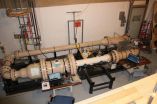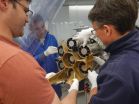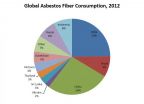(Press-News.org) Saturn's largest moon, Titan, is one of the few solar system bodies - and the only planetary moon - known to have fields of wind-blown dunes on its surface. (The others are Venus, Earth and Mars.)
New research, using experimental results from the high-pressure wind tunnel at Arizona State University's Planetary Aeolian Laboratory, has found that previous estimates of how fast winds need to blow to move sand-size particles around on Titan are about 40 percent too low.
A team of scientists led by Devon Burr of the University of Tennessee, Knoxville reported the findings Dec. 8 in a paper published in the journal Nature. James K. Smith, engineer and manager of ASU's Planetary Aeolian Laboratory, is one of the paper's co-authors.
Saturn and Titan orbit about ten times farther from the sun than Earth. Scientists got their first detailed information about Titan when the Cassini/Huygens orbiter and lander arrived in 2004. The short-lived Huygens lander took photos when it reached the surface and as it was descending through Titan's dense, smoggy atmosphere, which has 1.4 times greater pressure than Earth's. These images, plus studies using instruments on the Cassini orbiter, revealed that Titan's geological features include mountains, craters, river channels, lakes of ethane, methane and propane - and dunes.
Dunes begin to form when the wind picks up loose particles from the ground and drives them to hop, or saltate, downwind. A key part of understanding dunes is to identify the threshold wind speed that causes dune particles to start to move. Geologists have found threshold speeds for sand and dust under various conditions on Earth, Mars and Venus. But for Titan, with its bizarre conditions, this remained unknown.
Particles of 'Sand' as Light as Freeze-dried Coffee
On Titan, where the surface temperature is negative 290 degrees Fahrenheit, even "sand" is probably unlike sand on Earth, Mars or Venus. From the Cassini observations and other data, scientists think it is composed of small particles of solid hydrocarbons (or ice wrapped in hydrocarbons), with a density about one-third that of terrestrial sand. In addition, Titan's gravity is low, roughly one-seventh that on Earth. Combined with the particles' low density, this gives them a weight of only about four percent that of terrestrial sand, or roughly as light as freeze-dried coffee grains.
The scientists led by Burr began their study with carefully designed wind tunnel experiments. "We refurbished the high-pressure wind tunnel previously used to study conditions on Venus," Smith explains. To recreate in the tunnel on Earth the wind conditions on Titan, the scientists had to increase the air pressure in the wind tunnel to about 12 times the surface pressure of Earth. And they compensated for the low density of Titan "sand" and the moon's reduced gravity through numerical modeling.
In the end, the Burr team explains, "This simulation reproduces the fundamental physics governing particle motion thresholds on Titan." They add that previous studies, which had extrapolated from wind tunnel experiments designed to mimic conditions on Earth and Mars, produced results that were questionable under Titan's conditions.
The outcome of the wind tunnel experiments show that the previous calculations for wind speeds necessary to lift particles were about 40 to 50 percent too slow. The new experiments show that near the surface of Titan, the most easily moved sand-size particles need winds of at least 3.2 miles per hour (1.4 meters per second) to start moving.
That doesn't sound like much, says Nathan Bridges of the Johns Hopkins University Applied Physics Laboratory, one of the co-authors, "but it makes more sense when you realize this is a dense atmosphere blowing against particles that are very light."
A higher threshold wind speed for making particles move creates an either/or situation in which weak, everyday winds do little or nothing to surface particles, but occasional strong ones readily blow them around and reshape the dunes. The pattern of dunes on Titan shows that despite prevailing winds blowing from the east, the dunes appear shaped by winds from the west, which occur more rarely. Thus, the new work indicates that Titan's dunes are seldom stirred into motion - only whenever conditions produce strong westerly winds.
For simplicity, the wind-tunnel modeling ignored some factors, among them whether Titan dune particles are sticky. If they are, the paper's scientists note, then it will take yet-stronger winds to get the particles moving, and the contrasts will be even greater between the normal east wind pattern and the stronger west winds that shape the dunes.
Bridges says, "Titan is a strange place indeed."
INFORMATION:
The facility that has grown to become ASU's Planetary Aeolian Laboratory was founded in the mid-1970s by the late Ronald Greeley of ASU. The laboratory, located at NASA's Ames Research Center in Mountain View, California, has been used for many studies of how wind interacts with particles of sand, dust and rock. Scientists have also used it to investigate what blowing sand and dust do to Mars spacecraft, such as NASA's Opportunity and Curiosity rovers. ASU operates the laboratory through an agreement with NASA.
The School of Earth and Space Exploration is an academic unit of ASU's College of Liberal Arts and Sciences.
An enormous spectrum of light streams from the sun. We're most familiar with the conventional visible white light we see with our eyes from Earth, but that's just a fraction of what our closest star emits. NASA regularly watches the sun in numerous wavelengths because different wavelengths provide information about different temperatures and processes in space. Looking at all the wavelengths together helps to provide a complete picture of what's occurring on the sun over 92 million miles away - but no one has been able to focus on high energy X-rays from the sun until recently.
In ...
COLUMBUS, Ohio - When it comes to specialized cancer surgery, it's generally true that the more experienced the surgeon, the better the outcome. The same might hold true for radiation therapy used to treat head and neck cancer, according to a new study led by researchers Evan Wuthrick, MD, assistant professor of radiation oncology at The Ohio State University Comprehensive Cancer Center - Arthur G. James Cancer Hospital and Richard J. Solove Research Institute (OSUCCC - James), and Maura Gillison, MD, PhD, professor of internal medicine and epidemiology at the OSUCCC - ...
A team of researchers at Dartmouth College and University of Pittsburgh found respondents who had smoked water pipe tobacco but not smoked cigarettes were at increased risk of cigarette smoking two years later as recently published online in JAMA Pediatrics. The study followed 2,541 adolescents and young adults for two years.
Samir Soneji, PhD, a tobacco regulatory control researcher at Dartmouth and lead author on the study said, "We found hookah smoking increased the probability of trying cigarette smoking over the next two years by 19%."
This longitudinal study ...
Drinking or eating from cans or bottles lined with Bisphenol A (BPA) could raise your blood pressure, according to new research reported in the American Heart Association's journal Hypertension.
BPA, a chemical used as an epoxy lining for cans and plastic bottles, is everywhere, and its consumption has been associated with high blood pressure and heart rate variability. Previous studies have shown that BPA can leach into foods and drinks.
"A 5 mm Hg increase in systolic blood pressure by drinking two canned beverages may cause clinically significant problems, particularly ...
Nine in 10 primary care physicians say that prescription drug abuse is a moderate or big problem in their communities and nearly half say they are less likely to prescribe opioids to treat pain compared to a year ago, new Johns Hopkins Bloomberg School of Public Health research suggests.
Primary care doctors also appear to recognize many risks of prescription opioid use, including addiction and death by overdose, according to the findings reported in the Dec. 8 issue of JAMA Internal Medicine.
"Our findings suggest that primary care providers have become aware of the ...
A survey of primary care physicians found the vast majority of practicing internists, family physicians and general practitioners consider prescription drug abuse to be a significant problem in their community and most physicians agreed opioids were overused to treat pain, according to a research letter published online by JAMA Internal Medicine.
Primary care physicians are critical in maximizing the safe use of opioid pain-relieving medications. It is because of this that Catherine S. Hwang, M.S.P.H., of the Johns Hopkins Bloomberg School of Public Health, Baltimore, ...
Smoking water pipe tobacco from hookahs and using the smokeless tobacco snus were associated with initiating cigarette smoking and smoking cigarettes in the past 30 days among previously nonsmoking teenagers and young adults, according to a study published online by JAMA Pediatrics.
The Food and Drug Administration regulates cigarettes, loose tobacco and smokeless tobacco products. However, the FDA does not regulate the manufacturing, distribution and marketing of other tobacco products, such as water pipe tobacco, and many of those products are used by teenagers and ...
Salt Lake City - Develop 100 drugs in 10 years. That's the ambitious goal set by a group of scientists and engineers at the University of Utah, founders of Recursion Pharmaceuticals, a start-up company that is able to quickly and affordably identify unexpected ways a drug could be used by testing it on diseased cells.
The disruptive approach to drug development, aided by custom-designed software capable of tracking changes, or signs of healing, in cells, could speed discovery of therapies for so-called "orphan" diseases.
Scientists at Recursion have already identified ...
(SACRAMENTO, Calif.) -- Children with autism spectrum disorder (ASD) were more than twice as likely to have been exposed in utero to preeclampsia, and the likelihood of an autism diagnosis was even greater if the mother experienced more severe disease, a large study by researchers with the UC Davis MIND Institute has found.
Women with preeclampsia experience hypertension during the latter half of their pregnancies, and may have increased levels of protein in their urine and edema, or fluid retention. Preeclampsia can develop into eclampsia, a life-threatening condition ...
New York, NY, December 8, 2014 - Challenges to global health can evolve from policies and decisions that take years or decades to unfold. An article in the current issue of the Annals of Global Health describes the current state of asbestos use worldwide, a story that began over 100 years ago, and the real and contrived controversies regarding asbestos.
At the peak of asbestos use in 1972 in the United States, more than 775,000 tons of asbestos were used, much of it by the construction trades and shipbuilding industry, in addition to the manufacturing of many consumer ...



